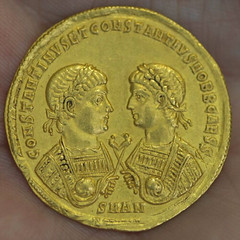
PREV ARTICLE
NEXT ARTICLE
FULL ISSUE
PREV FULL ISSUE
EXHIBIT: THE VICTOR ADDA COLLECTION
This article published June 21, 2017 discusses a new exhibit of Roman coins at the Israel Museum in Jerusalem
.
-Editor

Elagabalus is remembered as one of the most corrupt emperors in Roman history and did not shy from bloodshed. But he is also known for granting rights to women. The coins minted during his years on the throne clearly reflect his desire to shake up the accepted world order. On one side of the coins is the youthful face of the emperor and on the flip side are horses harnessed to a chariot carrying the holy meteorite with the Roman eagle above it. The coin was intended to make it clear that the Syrian god was on his way to join the pantheon of Roman gods. This coin can now be viewed in a new exhibit at the Israel Museum in Jerusalem, starting on Thursday. ”Faces of Power: Coins from the Victor Adda Collection” displays 75 gold coins of Roman emperors and their wives never shown to the public before. The collection of gold coins was donated to the Israel Museum by Johanna Adda Cohen, an 89-year-old resident of Rome. Her father, Victor Adda, was a Jewish businessman originally from Egypt and he collected the coins in the first half of the 20th century. When the family moved to Italy from Egypt, they smuggled the coins out in the pockets of relatives and friends.
The oldest coin is of Julius Caesar, who was the first living person to put his portrait on a Roman coin. His decision to use his portrait on coins was a major symbol of the change to one-man rule, and one of the causes of his assassination. On the reverse of a later coin (which is not part of the exhibit), minted by one of the most famous murderers in history, Brutus, can be seen the dagger, a symbol of the assassination. The portraits are most likely accurate reflections of the way the emperors really looked, without any major attempt to beautify, or “Photoshop” reality. Vespasian, the emperor remembered in Israel mostly for his siege of Jerusalem, is shown as rather ugly and fat with an angry face. The imperial gold coins were not originally intended for collectors or decoration, but were part of the foundation of the economy of the Roman Empire. “People held on to [the coins] because they knew they would keep their value,” says Gitler. Each gold coin was worth 25 silver coins, and every silver coin was worth 25 bronze coins. Mostly they were made from pure 24-karat gold. The entire exhibition has 518 grams of gold, worth about $22,000 just for the metal content. But the coin collection is worth an estimated $7.5 million.
To read the complete article, see:
The Numismatic Bibliomania Society is a non-profit organization promoting numismatic literature. See our web site at coinbooks.org. To submit items for publication in The E-Sylum, write to the Editor at this address: whomren@gmail.com To subscribe go to: https://my.binhost.com/lists/listinfo/esylum All Rights Reserved. NBS Home Page Contact the NBS webmaster 
|
